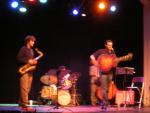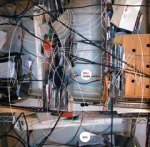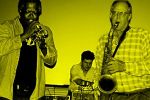Gino Robair, who stopped by the station for that interview yesterday, also dropped off a few goodies for us to spin on air. I gave them a sampling later in the show.

Full playlist is viewable here… and if you want to see the playlist of items spun during Robair’s interview, that’s here. Highlights/notes:
….. The New Black — [excerpt of, I think, side A] — The White Album (Rastascan, 2008). This is the album pictured above. Lovely, isn’t it! It comes as two black vinyl discs with black center labels inside black sleeves. No words, no art, no documentation.
The music was recorded direct-to-vinyl, and then the record duplicated for a limited 200-copy run. These are quartet improvisations (2 guitars, synth, drums) with a mysterious air. I played one of the more active sides, but there’s another that’s very quiet, built of small sparks of sound. It’s got an intensity to its silences. Side Four, or D, or whatever, consists of locked grooves. It was a full side-long improvisation, as A through C are, and the engineer selected needle-drop points to turn into locked grooves. How cool is that!
….. Gino Robair — I, Norton (Rastascan, 2009). From a demo of the forthcoming CD (Gino expects copies in-hand next week), we heard a variety of performances: Tom Duff as Norton, expounding; an acoustic instrumental passage from an sfSound performance, representing a band that Norton has stumbled upon while wandering; and an electronics piece of shimmering high-toned sounds, representing Norton’s death and his ascent into the light.
While the opera is meant to be disconnected from time and performed in arbitrary non-linear combinations, the CD is arranged to trace Norton’s life forward. It culls from multiple performances of the opera, and the electronics piece at the end wraps up beautifully with a heartbeat sound, something that popped up unexpectedly as Robair was doing live sound manipulation at the concert.
It’s going to be an interesting CD with a variety of sounds.
….. David Sait — “Waist Deep in Saigon” — Postage Paid Duets, Vol. 2 (Apprise, 2008). Sait plays guzheng and similar Asian stringed instruments. He recorded some solo improvisations, then mailed them out to partners such as Robair and LaDonna Smith to add their own sounds to. Volume 1 of the series was done entirely with Eugene Chadbourne.
 ….. John Butcher Group — “2” — Something To Be Said (Weight of Wax, 2009). This is an octet work combining acoustic instruments with analog synth and turntables (used for noise, not for beats), a hybrid of Butcher’s instructions and the group’s improvising.
….. John Butcher Group — “2” — Something To Be Said (Weight of Wax, 2009). This is an octet work combining acoustic instruments with analog synth and turntables (used for noise, not for beats), a hybrid of Butcher’s instructions and the group’s improvising.
Track 2 starts with an awesome cluster of percussion, a nice racket, tailing down into an active but quieter improv, a nice sense of action in an easygoing vein.
It’s the second release on Butcher’s Weight of Wax label. Considering the first came in 2005, you could call it a comeback.








